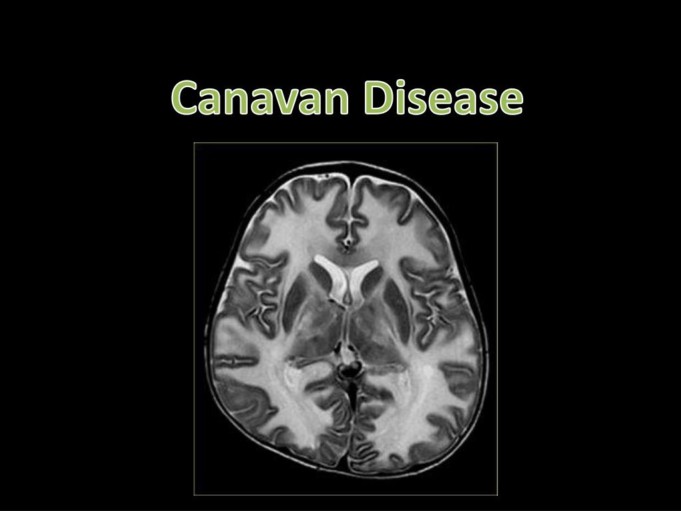Canavan disease, also known as Spongy degeneration of the central nervous system, is a rare, hereditary neurological disorder that begins in infancy.
The condition is caused by the lack of an essential enzyme that results in the degeneration of the white matter (myelin) in the brain, which prevents the proper transmission of nerve signals.
Infants affected with the disorder may seem normal at birth, but symptoms become apparent between 3-6 months of age.
The disease is characterized by a range of symptoms, including an abnormally large head (macrocephaly), inability to control the head, abnormal muscle tone that results in floppiness or stiffness, and delays in reaching infant developmental milestones sitting and walking.
Children affected with Canavan disease cannot walk, sit, crawl or talk. They may suffer seizures over time and become paralyzed. They may also have trouble swallowing.
Canavan disease belongs to a group of disorders called leukodystrophies. These are rare, hereditary metabolic disorders that affect the brain, spinal cord, and sometimes, the nerves in the peripheral nervous system. Many children affected with Canavan disease do not live past age 10. There is currently no cure for the disease. Treatment involves managing the symptoms of the disorder.
Canavan disease is usually found in people of Ashkenazi Jewish ancestry. About 1 in 40 Ashkenazi Jews is a carrier of the Canavan gene.
Signs and Symptoms of Canavan Disease
Symptoms of Canavan disease vary from one child to another. Children affected by the disorder may not share similar symptoms.
Common symptoms of Canavan disease are:
- Abnormally large head (macrocephaly)
- Poor control of the head and neck
- Reduced visual responsiveness
- Severely diminished muscle tone (hypotonia) resulting in stiffness or floppiness
- Apathy and lethargy
- Difficulty swallowing (dysphagia) with food sometimes flowing up into the nose
- A progressive loss of mental and muscular activity
- Mental retardation
- Unusual posture
- Inability to walk unassisted
- Deafness
- Sleep disturbances
Canavan disease is a progressive condition that worsens over time.
Causes of Canavan Disease
Canavan disease is caused by mutations in the ASPA gene. This gene is responsible for providing instructions for the production of the enzyme, aspartoacylase.
The role of the enzyme is to break down a specific compound called N-acetyl-L-aspartic acid, which is found in the nerve cells in the brain.
Mutations in the ASPA gene cause a reduced function of aspartoacylase which prevents the breakdown of NAA. This mutation causes Canavan disease.
Excess NAA in the brain is linked with the signs and symptoms of the disorder. This buildup of NNA leads to the progressive destruction of the myelin sheaths, which acts as a protective cover for neurons.
Diagnosis
Canavan disease is diagnosed by a prenatal blood test which can reveal if the fetus has the disease.
Treatment
There is no cure for Canavan disease. Treatment aims to reduce the severity of the child’s symptoms and improve their quality of life.
Treatment would vary depending on the individual symptoms. A medical professional, typically a paediatrician would determine how to meet the needs of the child best.
Physical therapy would go a long way in promoting better posture. Lithium and other medications may help control symptoms.
Sources;
- About Canavan Disease – Canavan Foundation
- Canavan Disease – MedlinePlus
- Canavan Disease – Healthline












